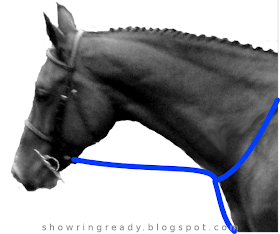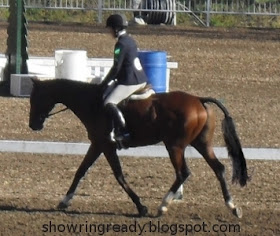You might be wondering how champion and reserve champion ribbons are awarded at some shows. Knowing how the recipients are determined can make it easier for you to know when to stick around for an award presentation or a tie-breaker.
There are a lot of rules relating to the awarding of championships, most of which I've posted below from the EC rule book. First I'll give a basic summary of the most useful information.
Championships are determined by adding up the points associated with each horse's placings in each of the classes of a division. The points are awarded as follows (even if the ribbons are awarded past sixth, no points will be given to those awarded a seventh place or lower):
1st - 7
2nd - 5
3rd - 4
4th - 3
5th - 2
6th - 1
The gap between first and second puts an emphasis on winning.
In a small class with consistent winners, the champion and reserve champion are likely to be those who are placing first and second in each class. In a larger class with a greater variety of horses placing (for instance in jumper divisions where a different set of horses might excel in a speed class), the champion and reserve champion are most likely to be the horses that have good results in most of the classes, even if they are not all top results. In some instances, a single first place ribbon can earn you a reserve championship.
If there is a tie in points, it is most likely to be resolved by a coin toss. In such a case, a representative of the rider will need to be present for the toss. The winner of the coin toss receives the ribbon. In the case of a tie for the championship, the winner becomes champion and the loser becomes the reserve champion.
Championships can only be awarded in divisions that have at least three classes.
For hunter championships, only the top four horses from the over fences classes (combined points from all of the classes) are eligible for the championship, although points from the under saddle class are added to finalize the placings. The prevents a spectacular mover from receiving a championship based on that movement rather than on the all-important jumping ability.
ARTICLE G204 HUNTER CHAMPIONSHIPS
1. Except as noted below, a competition may award hunter championships in each EC recognized hunter division providing there is a minimum of two over fences classes and one under saddle or hunter hack class in each division. If a competition offers more than one under saddle and/or hunter hack class in a division, only one may count for the championship unless the under saddle and/or hunter hack class is divided by height, age or breeding. If no under saddle class is held then one hunter hack class shall count and vice versa. The competition must specify in its prize list which full point and which half point classes in each division will count.
2. The following classes do not count towards nor make a horse eligible for a championship: breeding, local, maiden, novice, limit, pairs, teams, miscellaneous classes.
3. Points for championships shall be awarded on the following basis:
PLACING POINTS
1st 7
2nd 5
3rd 4
4th 3
5th 2
6th 1
4. The champion and reserve titles shall be awarded to two of the four horses which have accumulated the most points performing over a regulation hunter course required in the division in which they are being shown. In addition to these points, only these four horses shall receive half points for ribbons won in a model class and full points for ribbons won in one under saddle class or one hunter hack class.
5. In the case of a tie the championship and/or reserve shall be awarded to the horse that has accumulated the most points over fences. If there is still a tie, the tied horses shall be shown at walk, trot, canter and gallop (pregreen and green hunter not to gallop) to determine champion and reserve. Tossing a coin to break the tie is permissible if all participants agree. This competition shall be judged as an independent hunter under saddle class with conformation, quality, substance, soundness and performance to count as prescribed throughout the appropriate division.
6. In the event that all tied horses are declared unsound, selection of the winner amongst such tied horses shall be left to the discretion of the judge(s).
7. No classes shall count towards a championship unless all horses in the division have an equal opportunity to accumulate points. Any class that limits horse and/or rider should not count towards competition championships unless offset. This does not apply to sweepstakes or classics open to top qualifiers.
8. Points will be awarded for horses in hunter classics. In mixed classes (i.e. junior/amateur/children’s/adult), points shall be counted in their respective divisions (e.g. If the top-placed junior is 6th, he receives 6th-place points).
Classics in which juniors, amateurs and professionals are combined do not count for points.
9. Points won in one division do not count towards or make a horse eligible for the championship in another division.
10. To maintain awards won in a model class which is included in a division offered at a competition (e.g. conformation hunter), the entry must complete the course in at least one over fences class.
11. When a championship is offered, current standings must be posted at all times.
12. If there are several classes which are split but some with 50 or less entries which are not split, then the points won by the horses in this unsplit class shall be applied to their respective flight class for the calculation of championships. Separate championships must be offered when a majority of classes are divided.
13. If a class is split according to the "California split" (see Article G402) when reckoning championship points, the top eight horses that receive the most points over fences are awarded points in the under saddle/hunter hack/model class(es). The championships are awarded as follows:
Horse with the most points Champion #1
Horse with the second highest points Champion #2
Horse with the third highest points Reserve Champion #1
Horse with the fourth highest points Reserve Champion #2
14. At competitions where a separate championship class is held, horses must have been shown and judged in the qualifying classes.
ARTICLE G505 CHAMPIONSHIPS
1. A Jumper Championship and Reserve Championship may be awarded at each competition. The horse accumulating the most points will be Champion and the horse with the next largest number of points will be
Reserve Champion. The Championship will be decided upon the basis of points won in three or more full point classes. See also General Regulations.
2. In the case of a tie in a jumper class, each horse will be awarded equal points. For example, if three horses were tied for second place, each would receive second place points. The next placed horse would receive fifth place points.
3. In the case of a tie for the championship there may be a jump-off after the last jumping class of the Competition. Exhibitors tied for Champion or Reserve may elect to jump-off or toss.
4. Classes for Championship must be listed by number
5. Points for championships shall be awarded on the following basis:
PLACING POINTS
1st 7
2nd 5
3rd 4
4th 3
5th 2
6th 1



























